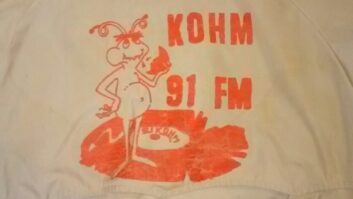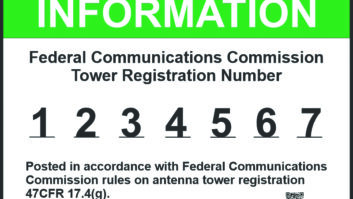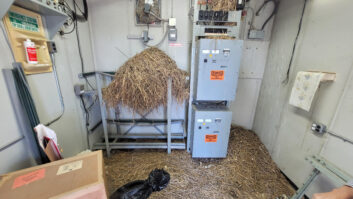Transmission Line Maintenance
Jul 1, 2010 12:00 PM, By Jeremy Ruck, PE

The lower transmission line is loosely resting on the metal braces, which will likely wear a hole in the outer jacket.
Transmission line is one of the unsung heroes of any broadcast facility. Without it, the signal goes nowhere. Although line is typically of a robust construction, like anything it requires a certain degree of maintenance. In some cases, a simple visual inspection combined with a little old-fashioned common sense may be sufficient, while in others a more detailed approach may be required. Either way, staying on top of inspections and maintenance tends to allow for better outage planning.
Buried transmission lines such as those utilized in an AM directional array, if properly installed, tend to require a minimal amount of maintenance. As long as they are buried at a sufficient depth to avoid erosion and damage from implements, they will typically function properly for many years. With an intact outer jacket, the tendency for galvanic corrosion and dielectric contamination, in the case of foam designs, is virtually non-existent. Nevertheless there is no downside to an occasional sweep of such lines to be sure.
Outside damage
Rigorous maintenance can reduce the impacts of potential damage, but elimination of all risk is likely not possible. Supporting structures for above ground transmission lines should be well maintained and replaced if necessary. Places where lines enter structures or the ground should be such that small movements in the line will not result in damage. Increase visibility and review such areas with all personnel involved at the site. To identify problem areas on the tower, use a competent crew. For significant construction projects, an inspection by a different crew may be worthwhile.
Correct each of the problems identified in a timely fashion. Common sense should tell you that when the transmission line is heard slapping against the tower in wind, an issue may be present. In that true case, the cost in rectifying a year later was considerably more expensive than if the problem had been addressed when initially identified.
Beyond the visual
There is also an electrical component to maintenance. The easiest method of examining the condition of a transmission line run is through the use of a network analyzer. Any such analyzer used for this purpose must be a vector analyzer with time domain options. A scalar analyzer simply will not provide the necessary information to accurately diagnose a run of line. In a pinch, or in cases where a network analyzer is not available, other pieces of equipment such as a time domain reflectometer or return loss bridge may provide sufficient information to identify the presence of a problem or be satisfactorily used for occasional incremental measurements.
— continued on page 2
Transmission Line Maintenance
Jul 1, 2010 12:00 PM, By Jeremy Ruck, PE
Unless subjected to damage or unusual stress, runs of foam or air dielectric semi-flexible transmission line will typically require minimal maintenance over their operational lifetimes. Although not always performed, replacement of hardware, O-rings and bullets every few years is a wise investment. These changes allow for easy visual checks at connection points, which tend to be the weakest points in the system.
Similarly, rigid transmission lines require maintenance, although to a somewhat greater degree depending on the design. Because steel and copper expand and contract at different rates, a mechanism is employed in rigid line sections to address this issue. Although there are some bellows designs where the center conductor itself expands and contracts, most designs use a watchband spring. In these types, the watchband spring, so colloquially named because of its appearance, is the contact point between the center conductor and bullet, and over time with continued expansion and contraction, suffers a reduction in its surface area. The decrease in the surface area of these springs results in gaps between the spring and the center conductor leading to the potential for arcing. Arcing, of course, is the leading cause of burnouts in transmission line.
Depending on with whom you talk, the replacement cycle on watchband springs and associated hardware varies. I have heard time frames from as long as 15 years to as short as seven years or so. Replacement every 10 to 12 years coupled with biennial or triennial sweeping of the system should catch better than 95 percent of non-malicious events, thus limiting unplanned off-air time and collateral damage.
Open wire
In the case of open wire line, maintenance is really quite simple, although it can be costly as are the installation costs, hence its minimal popularity. Typically, as long as there are no damaged insulators, support structures, breaks in the wires, or large amounts of corrosion or dirt present, this type of line will be in good shape. Due to the style of construction, visual inspections are quite simple to perform.
Finally, in the case of air dielectric lines, pressurization is a must. If pressurization is not used, the normal �breathing� of the transmission line at the joints and connections coupled with ambient temperature and humidity changes will allow for the ingress of water into the line. A minimal amount of water may have a substantial effect on the return loss of transmission line and ultimately can lead to failure via a variety of mechanisms. It cannot be stressed enough that air dielectric line with a substantial leak is a ticking time bomb that must be fixed as soon as possible.
The bottom line is that without maintenance, transmission line will ultimately fail. The good news is that with regular and periodic inspections, the likelihood of unplanned failures is greatly reduced. These inspections, however, are really a team effort between the transmitter engineer, tower crew and consultant. The seemingly large investment at the time amortized over several years really becomes a pittance when the number of hours in a year is considered, and is certainly far less than the incurred expense with catastrophic failure.
— More examples of transmission line damage are on page 3.
Ruck is a senior engineer with D.L. Markley and Associates, Peoria, IL.
Transmission Line Maintenance
Jul 1, 2010 12:00 PM, By Jeremy Ruck, PE
More examples of transmission line damage

Worn, corroded and damaged watchband springs from a rigid transmission line.

Arcing around this transmission line bullet has damaged this insulator.

Arcing was severe enough around this bullet to destroy the insulator ring.

Erosion has shifted the supports for this above-ground transmission line. The line shift is causing stress on the line reducer.

Before the jacket was removed, the crushed outer conductor was not obvious. A gin pole crushed the cable.

This elbow joint has signs of corrosion, as well as some metal debris that has collected. In time, the debris will cause problems.
Have your own photos to share? Send them to [email protected].












